Lichfield
| Lichfield | |
| Staffordshire | |
|---|---|
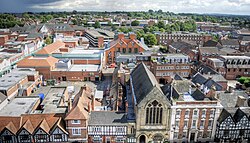 City of Lichfield | |
| Location | |
| Grid reference: | SK115097 |
| Location: | 52°41’7"N, 1°49’50"W |
| Data | |
| Population: | 30,050 (2007 est) |
| Post town: | Lichfield |
| Postcode: | WS13, WS14 |
| Dialling code: | 01543 |
| Local Government | |
| Council: | Lichfield |
| Parliamentary constituency: |
Lichfield |
Lichfield is a city in Staffordshire. It lies in the midst of rural Staffordshire, 16 miles north of Birmingham.
Lichfield is most famous for its three-spired cathedral, seat of the Diocese of Lichfield, and is an important ecclesiastical centre. Lichfield is also famed as the birthplace of Samuel Johnson, the author, wit and writer of the first authoritative Dictionary of the English Language.
Once the county's largest town, Lichfield did not undergo the industrial development which gripped other parts of Staffordshire, the Potteries and the Black Country. Its commercial development has been more modest and the city has accordingly remained a more modest size.
In July 2009, the Staffordshire Hoard, the largest hoard of Anglo-Saxon gold ever found in Britain was discovered in a field near Lichfield.
Geography
Lichfield is situated on Keuper sandstone between the high ground on Cannock Chase on the west and the valleys of the Rivers Trent and Tame on the east. The sandstone underlying the majority of Lichfield is shown in many of its ancient buildings including Lichfield Cathedral and the Church of St Chad.
Churches
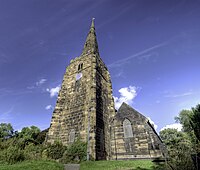
In the 2001 Census 80.4% of the people in the area professed the Christian faith. Lichfield has been a religious centre since St Chad built a monastery in 669. Lichfield Cathedral today still retains Lichfield's importance as a religious centre.
- Church of England:
- Baptist and United Reformed Church: Wade Street Church
- Methodist
- Pentecostal: Emmanuel Christian Centre (Nether Stowe)
- Roman Catholic:
- Holy Cross
- Ss' Peter & Paul
There are no places of worship in Lichfield for any other major world religions.
The name of the city
One local legend is that a thousand Christians were martyred in Lichfield around the year 300, during the reign of the Roman Emperor Diocletian, and that the name 'Lichfield' actually means 'field of the dead'. There is however, no evidence to support this legend and in Old English its name was Liccedfeld, not Licfeld.[1] At Wall, 3 miles to the south of the present city, there was a Romano-British]] village called Letocetum from the ancient British language for "grey wood", from which the first half of the name Lichfield is derived.[2] The second part of the name is derived from the Old English "feld", meaning 'field' or 'open country'.
History
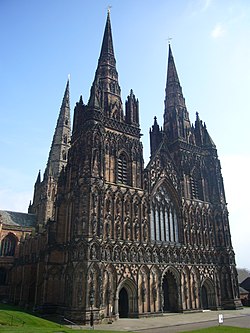
Early history: Religious centre of Mercian kings
The early history of Lichfield is obscure. The first authentic record of Lichfield occurs in Bede's history, where it is called Licidfelth and mentioned as the place where St Chad fixed the episcopal see of the Mercians in 669. The first Christian king of the Mercians, King Wulfhere donated land at Lichfield for Chad to build a monastery. It was because of this that the ecclesiastical centre of the Diocese of Mercia became settled at Lichfield, which was some 7 miles north of the seat of the Mercian kings at Tamworth. The first cathedral to be built on the present site was in 700 when Bishop Hedda built a new church to house the bones of St Chad which had become a sacred shrine to many pilgrims when he died in 672. The burial in the cathedral of the Mercian kings, King Wulfhere in 674 and King Ceolred in 716, further increased the prestige of Lichfield.[3] In 786 Offa, King of the Mercians, raised Lichfield to the dignity of an archbishopric, with authority over all the bishops from the Humber to the Thames. However after King Offa's death in 796, Lichfield's power waned and in 803 the primacy was restored to Canterbury after only 16 years. Nennius's Historia Britonum lists the city as one of the 28 cities of Britain around 833 AD.
9th century: Viking invaders and decline
During the 9th century, the Kingdom of Mercia was devastated by the Vikings. Lichfield itself was unwalled and the cathedral was despoiled, so Bishop Peter moved the see to the fortified and wealthier Chester in 1075. His successor, Robert de Limesey, transferred it to Coventry, but it was eventually restored to Lichfield in 1148. Work began on the present Gothic cathedral in 1195. At the time of the Domesday Book of 1086, Lichfield was held by the Bishop of Chester, whence the seat of the bishopric had been moved 10 years earlier; Lichfield was listed as a small village. The lord of the manor was the bishop of Chester until the reign of King Edward VI.
Middle Ages: New town laid out by Bishop Clinton
Bishop Clinton was responsible for transforming the scattered settlements to the south of Minster Pool into the ladder plan streets we recognise today. Market Street, Wade Street, Bore Street and Frog Lane linked Dam Street, Conduit Street and Bakers Lane on one side with Bird Street and St John Street on the other. Bishop Clinton also fortified the cathedral close, enclosed the town with a bank and ditch, and gates were set up where roads into the town crossed the ditch.[3] In 1291 Lichfield was severely damaged by a fire, which destroyed most of the town, however the Cathedral and Close survived unscathed.[4] In 1387 Richard II gave a charter for the foundation of the gild of St Mary and St John the Baptist; this gild functioned as the local government, until its dissolution by Edward VI, who incorporated the town in 1548.
16th century: Reformation and martyrs
Henry VIII had a dramatic affect on Lichfield. The Reformation ended pilgrim traffic following the destruction of St Chad's shrine in 1538 which was a major loss to the city's economic prosperity. That year too the Franciscan Friary was dissolved, the site becoming a private estate. Further economic decline followed the outbreak of plague in 1593, which resulted in the death of over a third of the entire population.[5]
Three people were burned at the stake for heresy under Mary I. The last person in England to be burnt at the stake for heresy was in Lichfield. Edward Wightman from Burton upon Trent was burnt at the stake in the Market Place on 11 April 1612 for refusing to recant his Baptist beliefs.
17th century: Destruction of the Civil War
In the English Civil War, Lichfield was divided. The cathedral authorities, with a certain following, were for the king, but the townsfolk generally sided with the Parliament. This led to the fortification of the close in 1643. Lichfield's position as a focus of supply routes had an important strategic significance during the war, and both forces were anxious for control of the city. Lord Brooke, notorious for his hostility to the church, led an assault against it, but was killed by a deflected bullet on St Chad's day, an accident welcomed as a miracle by the Royalists. The close yielded and was retaken by Prince Rupert of the Rhine in this year; but on the breakdown of the king's cause in 1646 it again surrendered. The cathedral suffered extensive damage from the war, including the complete destruction of the central spire. It was subsequently restored at the end of the Commonwealth period under the supervision of Bishop Hacket, and thanks in part to the generosity of King Charles II.
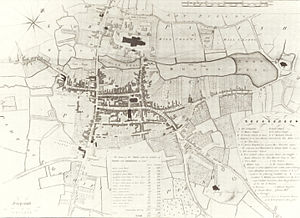
18th century: Thriving coaching city and cultural centre
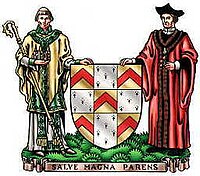
Lichfield started to develop a lively coaching trade as a stop-off on the busy route between London and Chester from the 1650s onwards, making it Staffordshire's most prosperous town. By the start of the 18th century the city thrived as a busy coaching city on the main route to the northwest and Ireland. It also became a centre of great intellectual activity being the home of many famous people including Samuel Johnson, David Garrick, Erasmus Darwin and Anna Seward, this prompted Johnson's remark that Lichfield was "a city of philosophers". In the 1720s Daniel Defoe described Lichfield as 'a fine, neat, well-built, and indifferent large city', the principal town in the region after Chester.[6] An infantry regiment of the British Army was formed at Lichfield in 1705 by Col. Luke Lillingstone in the King's Head pub in Bird Street. In 1751 it became the 38th regiment of foot and in 1783 the 1st Staffordshire Regiment; after reorganization in 1881 it became the 1st battalion of the South Staffordshire Regiment.[6]
19th century: Industrial Revolution and decline
The arrival of the Industrial Revolution and the railways in the 19th century ended Lichfield's position as an important staging post for coaching traffic. Whilst the industrial development at nearby Birmingham exploded, along with its population, Lichfield remained largely unchanged in character.
20th century: World War II and post-War expansion
The first council houses were built in the Dimbles area of the city in the 1930s. The outbreak of World War II brought over 2,000 evacuees from industrialised areas. However due to the lack of heavy industry in the city, Lichfield escaped lightly, although there were air raids in 1940 and 1941 and 3 Lichfield folk were killed. Just outside the city Wellington Bombers flew out of Fradley Aerodrome which was known as RAF Lichfield. After the war the council built many new houses in the 1960s including some high-rise flats, the late 70s and early 80s brought a large housing estate at Boley Park in the east of the city. The city's population tripled between 1951 and the late 1980s. Today the city continues to expand; to the west, a new area of housing has been under development for a number of years which has swelled the city's population by some 3,000.
Places of Interest
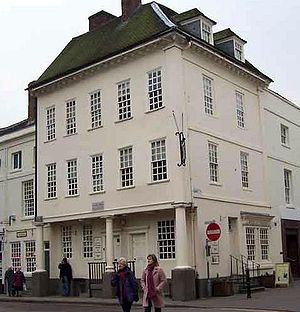
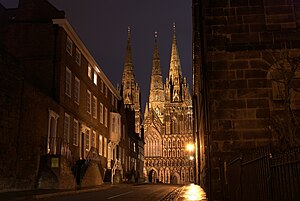
- Lichfield Cathedral - England's only mediaeval Cathedral with three spires. It is also the only mediaeval cathedral in Europe with three spires. The present building was started in 1195, and completed by the building of the Lady Chapel in the 1330s. It replaced a Norman building begun in 1085 which had replaced one, or possibly two, Saxon buildings from the seventh century. There is currently work taking place on the stone structure and glass windows.
- The Cathedral Close - Surrounding the Cathedral with its many fine buildings is one of the most unspoilt in the country.
- The Samuel Johnson Birthplace Museum - A museum to Samuel Johnson's life, work and personality.
- Erasmus Darwin House - Home to Erasmus Darwin, the house was restored to create a museum which opened to the public in 1999.
- Lichfield Heritage Centre - in St Mary's Church in the market square, an exhibition of 2,000 years of Lichfield's history.
- The Bishop's Palace - Built in 1687, and a theological college built in 1837 are adjacent to the Cathedral.
- Milley's Hospital - Located on Beacon Street, it dates back to 1504 and was a women's hospital.
- Hospital of St John Baptist without the Barrs - A distinctive tudor building with a row of eight brick chimneys. This was built outside the city walls (barrs) to provide accommodation for travellers arriving after the city gates were closed. It now provides home for retired gentlemen and has an adjacent Chapel.
- Church of St Chad - A 12th century church though extensively restored, on its site is a Holy Well by which St Chad is said to have prayed and used the waters healing properties.
- St Michael on Greenhill - Overlooking the city the ancient churchyard is unique as one of the largest in the country at 9 acres.
- Christ Church - An outstanding example of Victorian ecclesiastical architecture and a Grade II* listed building.
- The Market Square - In the centre of the city the square contains two statues, one of Samuel Johnson overlooking the house in which he was born, and one of his great friend and biographer, James Boswell.
- Beacon Park - An 81 acre public park in the centre of the city, used for many sporting and recreational activities.
- The Franciscan Friary - The ruins of the former Friary in Lichfield, now classed as a Scheduled Ancient Monument
Nearby
- Wall Roman Site - The remains of a Roman settlement, 1| mile south of the city.
- Staffordshire Regiment Museum – 2½ miles east of the city in Whittington, the museum covers the regiment's history, activities and members, and include photographs, uniforms, weapons, medals, artifacts, memorabilia and regimental regalia. Outdoors is a replica trench from World War I, and several armoured fighting vehicles.
- National Memorial Arboretum – 4 miles northeast of the city in Alrewas, the arboretum is a national site of remembrance and contains many memorials to the armed services.
- Cannock Chase - A designated Area of Outstanding Natural Beauty, is 5 miles northwest of the city. It comprises a mixture of natural deciduous woodland, coniferous plantations and open heathland. There are a number of visitor centres, museums and waymarked paths, including the Heart of England Way and the Staffordshire Way.
- Shugborough Hall - On Cannock Chase's north-eastern edge, the ancestral home of the Earls of Lichfield.
Economy
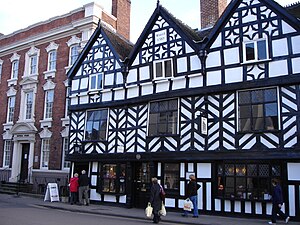
Lichfield's wealth grew along with its importance as an ecclesiastical centre. The original settlement prospered as the place where pilgrims gathered to worship at the shrine of St Chad, this practice continued up until the Reformation when the shrine was destroyed.
In the Middle Ages, the main industry in Lichfield was making woollen cloth. There was also a leather industry in Lichfield. Much of the surrounding area was open pasture and there were many surrounding farms.
In the 18th century, Lichfield became a busy coaching centre, there was little industry, the main source of wealth to the city coming from the money generated by its many visitors. The invention of the railways saw the decline in coach travel and with it came the decline in Lichfield's prosperity.
By the end of the 19th century, brewing was the principal industry, and in the neighbourhood were large market gardens which provided food for the growing populations of nearby Birmingham and the Black Country.
Today there are a number of light industrial areas predominantly in the east of the city, not dominated by any one particular industry. The district is famous for two local products: Armitage Shanks sanitary fittings and Arthur Price of England, cutlers and silversmiths. Many residents commute to Birmingham.
Culture
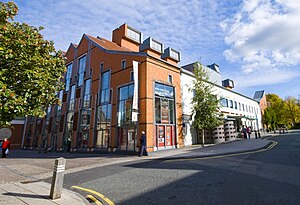
The Garrick Theatre was opened in 2003 replacing the Civic Hall, which was built in the 1970s. Each year in July The Lichfield Festival takes place, based primarily around the cathedral and the Garrick Theatre, it is celebration of classical music, dance, drama, film, jazz literature, poetry, visual arts and world music.[7] Since 1995 the Festival has incorporated a Mediaeval Market, taking place in the Cathedral Close.
Once every three years, The Lichfield Mystery Play cycle is performed in the Cathedral, the Market Place and on Stowe Fields. It is a cycle of 26 mediaeval plays involving nearly 1000 people, making it one of the largest community arts events in Europe.[8]
In 2009 the first Inspire Film Festival took place at the Garrick theatre, created by a group of local media students. The event featured short films and documentaries from students all over the country.
The Lichfield Bower takes place on Spring Bank Holiday Monday, it dates back to the Middle Ages, when the townsfolk, after fulfilling their duty of attendance at the Court of Arraye, were given the rest of the day as holiday. A procession of marching bands and carnival floats makes its way through the city, where the Bower Queen is crowned outside the Guildhall at noon. There is also a fun fair in the city centre, and a fair and jamboree in Beacon Park.
The Lichfield Real Ale, Jazz & Blues Festival takes place in June each year.
The Bloodstock Open Air heavy metal music festival takes place every year at Catton Hall, some 7 miles outside of Lichfield.
References
- ↑ "Explaining the origin of the 'field of the dead' legend". British History Online. http://www.british-history.ac.uk/report.aspx?compid=42340. Retrieved 20 November 2008.
- ↑ "English Place Name Society Database at Nottingham University". Nottingham.ac.uk. http://www.nottingham.ac.uk/~cczappdv/epnnewmap/detailpop.php?placeno=9823. Retrieved 2010-07-17.
- ↑ 3.0 3.1 From: 'Lichfield: History to c.1500', A History of the County of Stafford: Volume 14: Lichfield (1990), pp. 4-14. URL: http://www.british-history.ac.uk/report.aspx?compid=42336 Date accessed: 24 July 2009.
- ↑ "Brief History of Lichfield". Local Histories. http://www.localhistories.org/lichfield.html. Retrieved 20 November 2008.
- ↑ "'Lichfield: From the Reformation to c.1800', A History of the County of Stafford: Volume 14: Lichfield (1990), pp. 14-24.". British History Online. http://www.british-history.ac.uk/report.aspx?compid=42337. Retrieved 22 November 2008.
- ↑ 6.0 6.1 From: 'Lichfield: From the Reformation to c.1800', A History of the County of Stafford: Volume 14: Lichfield (1990), pp. 14-24. URL: http://www.british-history.ac.uk/report.aspx?compid=42337 Date accessed: 24 July 2009.
- ↑ "About The Lichfield Festival". Lichfield Festival. Archived from the original on 1 August 2008. http://web.archive.org/web/20080801145829/http://www.lichfieldfestival.org/2008/content/view/25/40/. Retrieved 1 January 2009.
- ↑ "About The Lichfield Mysteries". http://www.lichfieldmysteries.co.uk/. Retrieved 1 January 2009.